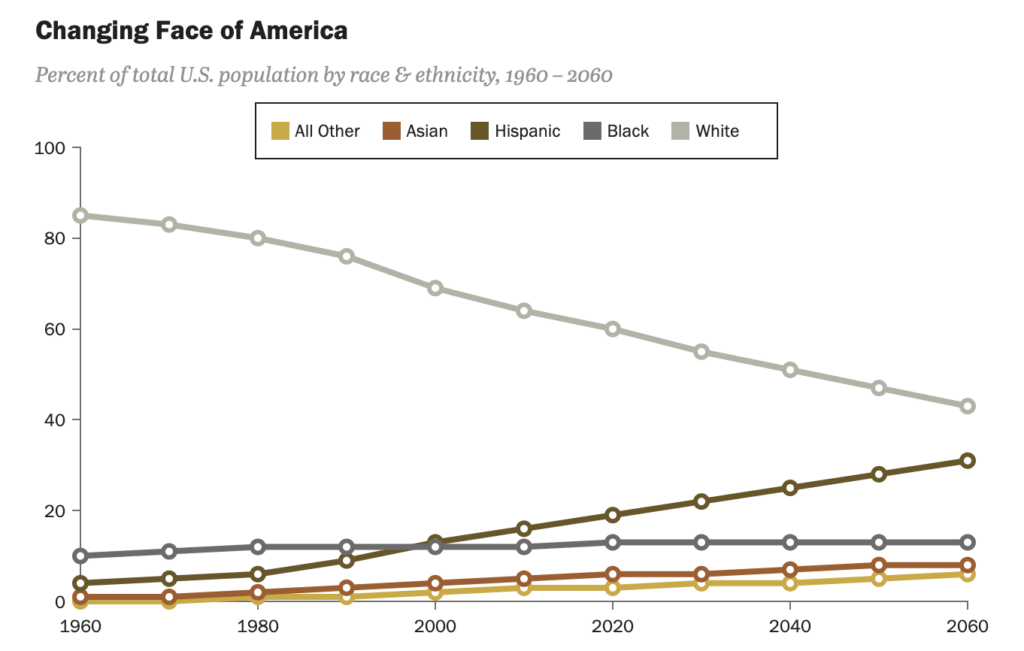|
Getting your Trinity Audio player ready…
|

Data analysis is fundamental to understanding the demographic transformations occurring in the United States. The country is becoming predominantly non-white while a record share of the population is aging. These simultaneous changes create significant generational gaps that affect politics, the economy, and social cohesion.
Demographic data shows that the white population, which was 85% in 1960, will be only 43% in 2060. This change is driven by more than 40 million immigrants who have arrived since 1965, many of them Hispanic and Asian. Analyzing these data helps understand how racial and ethnic diversity is reshaping American society.
In addition to racial changes, data analysis reveals the aging population. The traditional age pyramid is transforming into a rectangle, with nearly as many Americans over 85 as those under 5. This phenomenon, resulting from higher life expectancy and lower birth rates, presents significant economic and political challenges.
Economic data analysis is equally important. Millennials (people born between 1981 and 1996), for example, are well-educated and tech-savvy but face difficulties in the job market, risking a lower standard of living than their parents. Data on employment, income, and education are essential to understanding these dynamics and developing policies to mitigate these challenges.

Data also shows that about 10,000 Baby Boomers (people born between 1940s and 1960s) are retiring daily, many without adequate financial preparation. This adds additional pressure on the social safety net and requires policy solutions that balance the needs of the elderly without overburdening young workers.
Public opinion data reveals deep political and social divisions. One political party tends to be older, white, religious, and conservative, while the other is younger, diverse, liberal, and secular. These divisions are exacerbated by animosity between partisans, affecting not only politics but also daily life.
Data also shows that many Americans are disillusioned with politics and desire pragmatic compromises. However, these individuals are less likely to vote and engage actively in politics, creating a paradox where the silent majority desires change but does not actively participate in the process.
Data analysis is crucial to understanding these dynamics and developing strategies to increase civic participation. Opinion polls and demographic data help identify barriers to participation and develop more effective engagement campaigns.
Demographic transformation also has implications for social cohesion. Data analysis can help identify areas of tension and develop policies that promote integration and social harmony. Data on education, employment, and housing are particularly important in this context.
Data analysis is also vital for understanding changes in family structures. American families are becoming more diverse in terms of composition and dynamics. Data on marriage, divorce, birth rates, and adoption help paint a more complete picture of these changes and develop policies that support all forms of family.
Technology is another important factor. Data analysis shows how technology use varies across generations and how this affects communication, work, and leisure. Understanding these differences is crucial for developing policies that promote digital inclusion and leverage the opportunities offered by technology.

Data analysis also plays a crucial role in education. Data on academic performance, access to education, and educational disparities help identify areas of need and develop policies that promote educational equity.
Public health is another area where data analysis is essential. Data on health, access to medical care, and health disparities help develop policies that promote the health and well-being of all Americans.
Data analysis is fundamental to understanding cultural and social changes. Data on religion, values, and social norms help paint a more complete picture of American society and develop policies that reflect these changes.
Data analysis is a powerful tool that helps us understand the complex transformations shaping the United States. By providing deep insights into demographics, economics, politics, and culture, data analysis allows us to develop more informed and effective policies to address future challenges.

